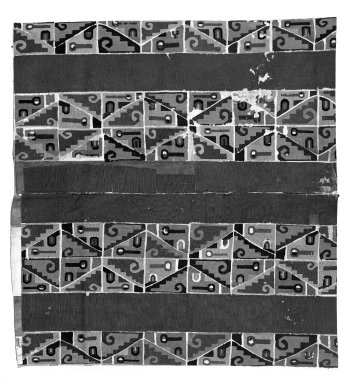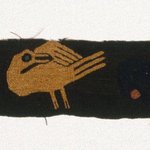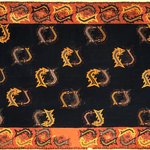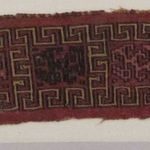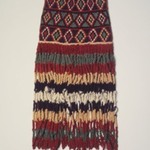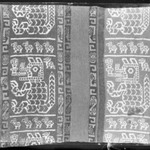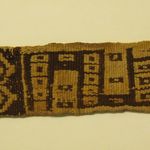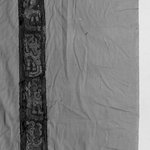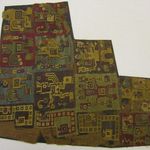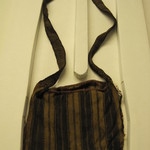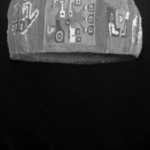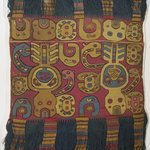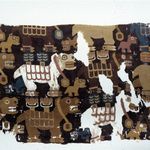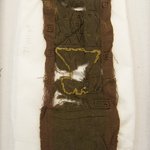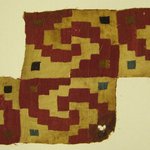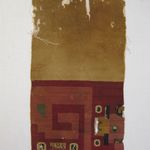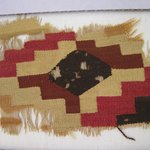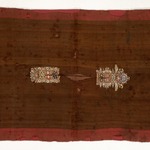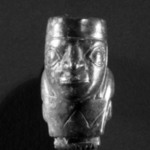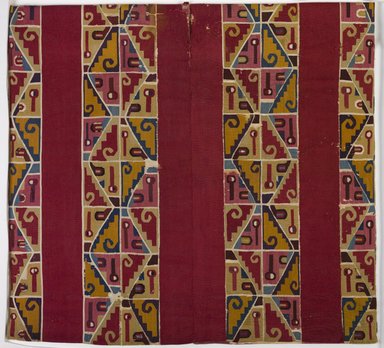

Wari. Tunic, 600–1000. Cotton, camelid fiber, 39 x 41 5/16 in. (99.1 x 104.9 cm). Brooklyn Museum, Gift of the Ernest Erickson Foundation, Inc., 86.224.144. Creative Commons-BY (Photo: , 86.224.144_PS9.jpg)
Tunic
Arts of the Americas
CULTURE
Wari
MEDIUM
Cotton, camelid fiber
DATES
600–1000
PERIOD
Middle Horizon Period
DIMENSIONS
39 x 41 5/16 in. (99.1 x 104.9 cm) (show scale)



COLLECTIONS
Arts of the Americas
ACCESSION NUMBER
86.224.144
CREDIT LINE
Gift of the Ernest Erickson Foundation, Inc.
CATALOGUE DESCRIPTION
Tapestry tunic (shirt) with neck and arm openings. Decoration consists of four patterned alternating with three plain vertical bands, of a deep rich red. The decorated bands are divided into white-bordered rectangles, triangles, or diamonds within which geometric, profile faces are paired with step motifs and frets. The faces have eyes that are vertically split, bi-colored, and surrounded by a contrasting band that turns into a long thin rectangle through the cheek. The mouths are formed by three U-shaped bands of color. A triangular contrasting color may be a nose. The chin form juts out. Color patterning and reversals are complex; generally, the faces are either pink against a blue ground or beige against brown, and the step motifs are a deep red against beige or gold against a blue to some purplish ground. The motifs at the outermost edges show some of the characteristic compression of Wari tunics. This effect is more pronounced in some areas than others. Condition: Loss of fibers especially in areas where white appears. Neck area worn. Scattered losses across the surface.
Size: adult. Probable wearer: male. Horizontal cotton warp. Cotton, camelid fiber weft. Tapestry weave with interlocked discontinuous wefts (reversible). Unku. Reverse side out (NK) Design: profile face (no fangs) and fret, little compression (AR)
MUSEUM LOCATION
This item is not on view
CAPTION
Wari. Tunic, 600–1000. Cotton, camelid fiber, 39 x 41 5/16 in. (99.1 x 104.9 cm). Brooklyn Museum, Gift of the Ernest Erickson Foundation, Inc., 86.224.144. Creative Commons-BY (Photo: , 86.224.144_PS9.jpg)
IMAGE
overall, 86.224.144_PS9.jpg., 2018
"CUR" at the beginning of an image file name means that the image was created by a curatorial staff member. These study images may be digital point-and-shoot photographs, when we don\'t yet have high-quality studio photography, or they may be scans of older negatives, slides, or photographic prints, providing historical documentation of the object.
RIGHTS STATEMENT
Creative Commons-BY
You may download and use Brooklyn Museum images of this three-dimensional work in accordance with a Creative Commons license. Fair use, as understood under the United States Copyright Act, may also apply.
Please include caption information from this page and credit the Brooklyn Museum. If you need a high resolution file, please fill out our online application form (charges apply).
For further information about copyright, we recommend resources at the United States Library of Congress, Cornell University, Copyright and Cultural Institutions: Guidelines for U.S. Libraries, Archives, and Museums, and Copyright Watch.
For more information about the Museum's rights project, including how rights types are assigned, please see our blog posts on copyright.
If you have any information regarding this work and rights to it, please contact copyright@brooklynmuseum.org.
RECORD COMPLETENESS
Not every record you will find here is complete. More information is available for some works than for others, and some entries have been updated more recently. Records are frequently reviewed and revised, and we welcome any additional information you might have.
